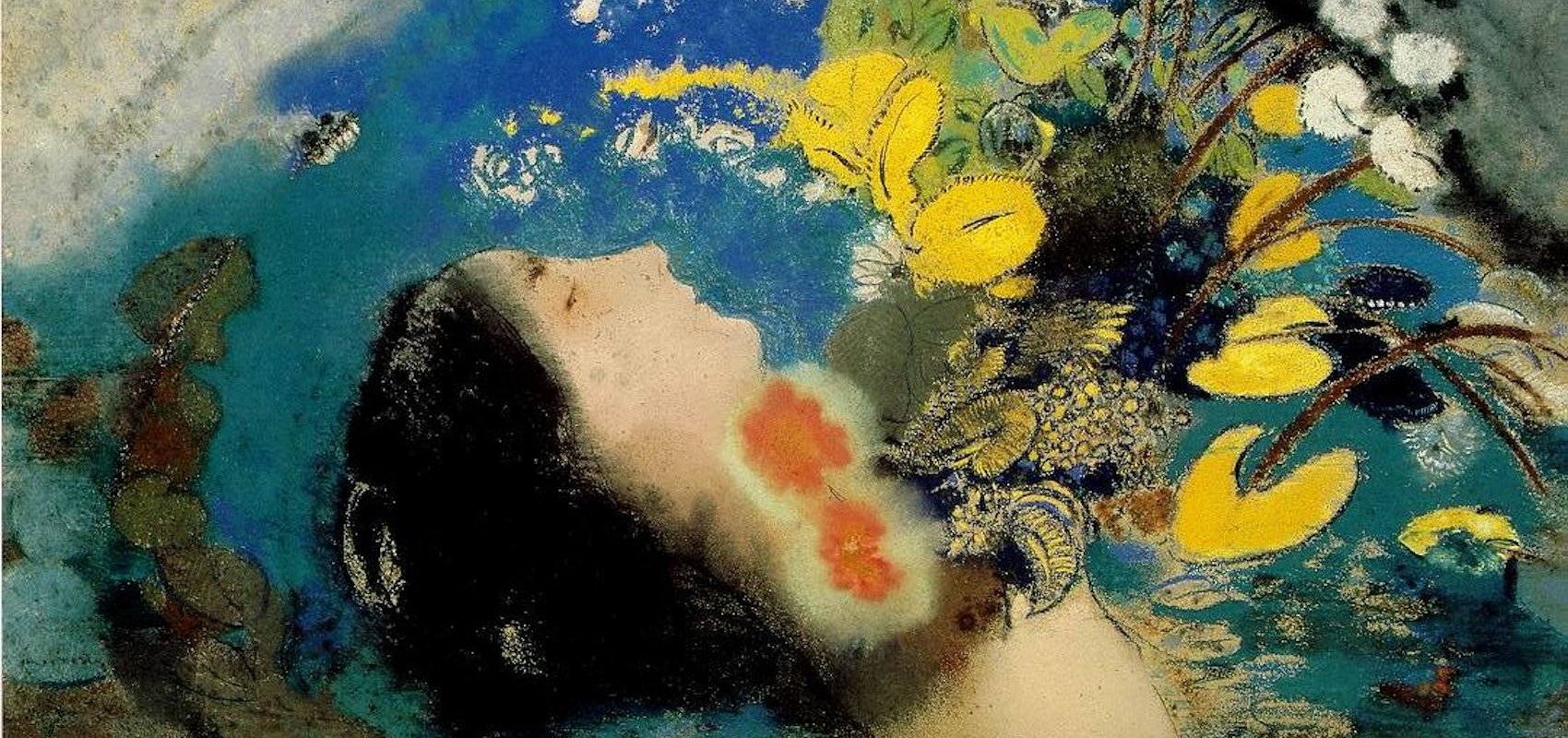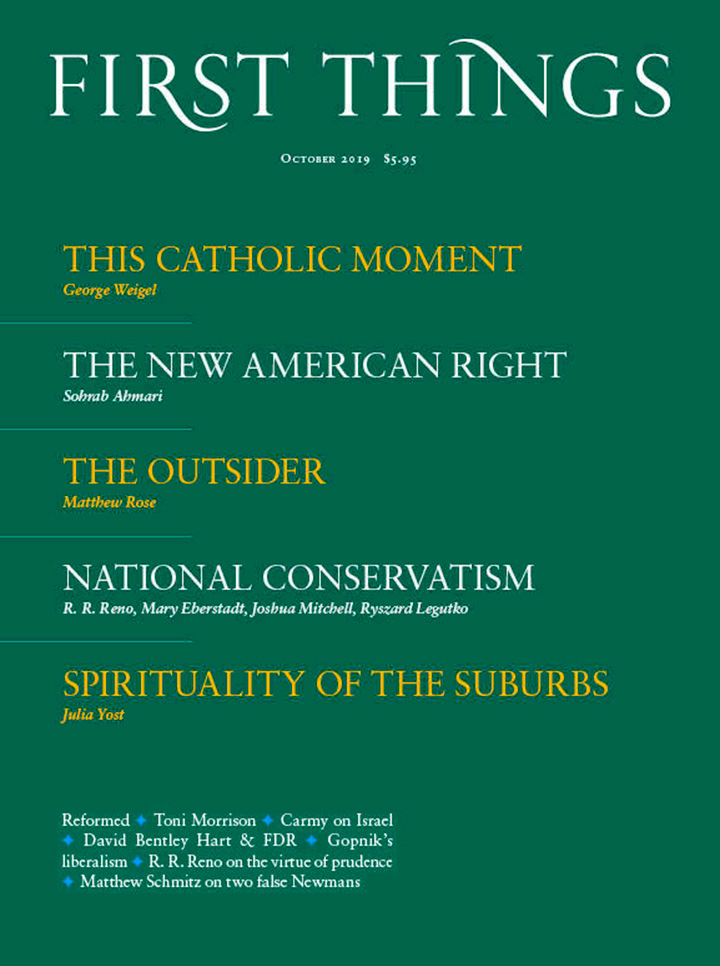
Obituaries for Toni Morrison, who died on August 5, remember her as a Nobel Prize–winning novelist, a black woman novelist, and the last great American novelist—never a Catholic novelist. Morrison converted to Catholicism at age twelve but stood aloof from the Church for years. Despite a few game attempts by the pious press to claim her, Morrison’s Catholicism is a biographical fact, not a literary one.
Her novels are not credally Christian but pop-gnostic. Pop-gnosticism is a cult by and for the bourgeoisie, an artifact of the worst early-Christian scholarship of the 1970s and the still worse late-Freudian psychology of the 1980s. Morrison made her fiction debut in 1970 but achieved her greatest success in 1987 with Beloved, on the strength of which she received an appointment at Princeton and the 1993 Nobel Prize in Literature. In the 1990s and 2000s, the patronage of Oprah Winfrey brought her a still broader readership, one drawn primarily by her novels’ portrayals of therapeutic self-realization. Morrison achieved immense success by distilling the spirituality of the suburbs.
The architect of pop-gnosticism is Morrison’s Princeton colleague, the religious historian Elaine Pagels, whose seminal book The Gnostic Gospels (1979) sketched a very American style of gnosticism and passed it off as a lost tradition of early Christianity. Pagels’s gnosticism is not much concerned with the corruption of the material world, which exercised the Marcionites and other ancients. Its emphasis is rather on the tenet that we are redeemed by gnosis, by knowledge of our true spiritual selves.
This style of gnosticism—called by one observer “the cult of the God Within”—is now the dominant American religion. It proposes internal harmony as the chief end of religion. Naturally, we wish to externalize this harmony: “If you bring forth what is within you, what you bring forth will save you. If you do not bring forth what is within you, what you do not bring forth will destroy you,” says Jesus in the Gospel of Thomas, a crucial text for Pagels.
Morrison’s affinity for this style of gnosticism is evident in much of her fiction, most explicitly in Paradise (1997), in which a syncretic faith focused on psychological healing replaces traditional Christian creeds among a “convent” of traumatized women in Oklahoma. Under the direction of the charismatic Consolata, a gnostic “divine mother” such as Pagels describes, the women dabble in Egyptian gnosticism and Brazilian Candomblé. The novel’s epigraph quotes from a poem discovered, along with the Gospel of Thomas, among gnostic manuscripts in Nag Hammadi, Egypt, in the 1940s.
“If you bring forth what is within you, what you bring forth will save you.” The parallels between pop-gnosticism and psychotherapy are patent, and Pagels makes them explicit: “Both gnosticism and psychotherapy value, above all, knowledge—the self-knowledge which is insight.” Again: “For gnostics, exploring the psyche became explicitly what it is for many people today implicitly—a religious quest.” In Paradise, Consolata directs her followers to heal themselves by narrating their pasts. What would Jesus do? See a therapist.
Morrison’s Beloved is a “spiritual” novel, in two senses: It is a ghost story (or spirit story); and its ghost metaphorizes the god (or spirit) within, which may be encountered in therapeutic gnosis. Sethe, a former slave, lives in a house that is haunted by the ghost of her baby daughter, whom she murdered years earlier to prevent her being taken back to slavery. In the summer of 1873, from the river behind the house emerges a beautiful young woman—the incarnate ghost of Sethe’s “beloved” daughter, now grown. In psychoanalytic terms, Beloved represents the return of the repressed. Sethe has been repressing the traumas of her life as a slave: “She worked hard to remember as close to nothing as was safe,” and she begins each day “beating back the past.” Sethe secludes herself with Beloved, whose behavior becomes vampiric (“what you do not bring forth will destroy you”). Finally Beloved is exorcised by a retinue of neighbor women whose chanting spurs Sethe to reenact the original scene of trauma, with a difference: She attacks a white man who is passing by, turning her violence upon the oppressors and away from her child. Once the traumatic memory has been elicited and amended, Beloved disappears.
Following the therapeutic script, Sethe gets in touch with the God Within. As her lover assures her at the end: “You your best thing, Sethe.” The guru of Beloved is Baby Suggs, who preaches the same gospel: “She did not tell them to clean up their lives or to go and sin no more. . . . She told them that the only grace they could have was the grace they could imagine.”
Beloved is of its time in its treatment of trauma and repressed memory. The theory that caught on among mental health professionals in the 1980s—indebted to Freud’s “seduction theory”—was that the psyche represses its memories of traumatic experiences (paradigmatically, sexual abuse during childhood), and that the repressed memories cause symptoms, which will not be resolved until the memories have been recovered and expressed. The decade’s signature therapeutic methodology was evocative psychotherapy, in which therapeutic subjects were urged, often with the aid of hypnosis and psychotropic drugs, to remember their forgotten traumas. Beloved draws on these methods, so much so that it can be criticized for its rote transcription of psychoanalytic practice into narrative.
Within the past twenty years, this clinical practice has been discarded, and the “memories” evoked in therapy reclassified as False Memory Syndrome. The recovered-memory movement was a misapplication of clinical expertise, a grotesque effect of the death-throes of Freudian psychotherapy. But it had a great run, and today it enjoys an exasperating new respectability. In the age of #MeToo, journalists and victims’ advocates are reopening the question of its legitimacy, often suggesting that the American Psychiatric Association, which happily embraced recovered memory until it was forced to repudiate it, is a tool of patriarchy.
But there are reasons beyond the political why recovered memory won’t go away: It is a seductive thesis. Like pop-gnosticism, it thrillingly promises that your psyche is deep and contains revelations, if you can just crack the code and bring forth what is within you. In the mythology of recovered memory, bourgeois sexual neurosis signals profounder and grander disturbances. Morrison extends the myth when she analogizes the domestic traumas of the individual psyche to the racial traumas of slavery. In the ghostly figure of Beloved, Morrison compresses not only the personal traumas of Sethe, but the racial trauma of the “sixty million and more” victims of American slavery, to whom the novel is dedicated. Readers are directed to recover the historical past, just as we must recover our personal pasts.
No doubt this is a wise injunction; Morrison writes compellingly of our “national amnesia” concerning slavery. But there is a problem with the use of the term “trauma” to denote racial or colonial suffering. The concept of psychological trauma was invented to diagnose the troubles of the bourgeoisie. “Psychological trauma” arises from the anomalous bad events that may befall a person whose existence is broadly secure—a sexual assault, a car accident, a tornado—and issues in neurotic malaise. How does this template apply to racial or colonial suffering, which is a collective rather than individual experience, normative rather than anomalous, a system of subjugation rather than a discrete event, and whose victims lack the leisure for malaise? By proposing a titillating correspondence between the neuroses of privilege and the sufferings of the wretched, Beloved aggrandizes the former and trivializes the latter.
It is not exactly fair, and neither is it exactly unfair, to judge Morrison’s work by the use Oprah Winfrey made of it. Media critic Rebecca Wanzo recounts: “Morrison’s novels were chosen . . . more frequently than any other author’s during the first Oprah’s Book Club, which ran from 1996 to 2002.” In pitching Morrison’s novels to her daytime TV audience, Winfrey stressed that they contained “mechanisms for self-transformation”—for therapeutic gnosis. Morrison’s novels are not reducible to their gnosticism; their gnosticism, however, is reducible to suburban banalities about self-realization and self-affirmation. Not without warrant, Winfrey presented the Morrison canon as wisdom literature for soccer moms. Conflating Sethe’s subjugation as a slave with the challenges facing her middle-class viewers, she glossed Beloved as a novel about “self-determination for women.”
In other words, Beloved is about slavery; more important, it is about me. Seeing my struggles and triumphs mirrored in Sethe’s, I find that my psyche is as vast as the history of a race, an undiscovered country of repression and oppression. The problem with sentimental political literature is at least as old as Uncle Tom’s Cabin. In reading, I learn something about myself: that I am more empathetic, or more personally tragic, than anyone suspected. The discovery is cathartic, and my reading need not motivate action.
Beloved is a central text of trauma studies, a literary subfield that seeks to recover “what is normally repressed in the dominant order.” Even outside that subfield, critics of Beloved have understood themselves as participating in Morrison’s project of giving voice to the repressed and oppressed. This collaborative agenda may have insulated Beloved from reassessment—of its aesthetic value, of the truth of its account of the human psyche, and of the ethics of its comparison of racial suffering with individual trauma.
Morrison shares with our literary ascendancy not only a politics but, more powerfully, a spirituality: a sense of where god is to be found and what the soul seeks. The charm of this view, as distinct from traditional religion, is that in twinning spirituality with a program of earthly progress, it imparts to politics a horizon beyond earth. If the particularities of Morrison’s spirituality strike us as very seventies, very eighties, or very nineties, it may not matter much in the long run. Her reliance on dated theology and psychology need not endanger her stature in posterity any more than Dante’s faulty astronomy did his. Gnosticism, after all, will always appeal. But to what in us does it appeal? As Philip Rieff wrote, “Religious man was born to be saved; psychological man is born to be pleased.” In Morrison, we have the laureate we deserve.
In Praise of Translation
This essay was delivered as the 38th Annual Erasmus Lecture. The circumstances of my life have been…
Work Is for the Worker
In these early days of his pontificate, Pope Leo XIV has made one thing clear: The responsible…
Goddity
The Nativity of our Lord—born an infant, laid in a manger. It’s an utterly strange story: The…



